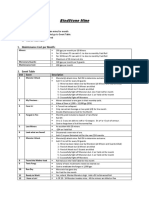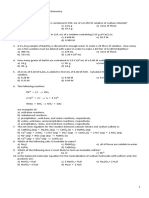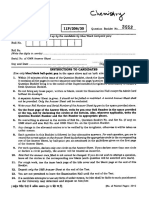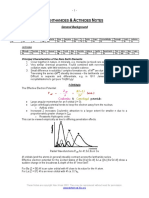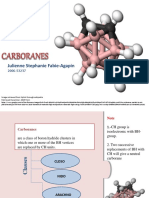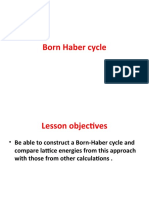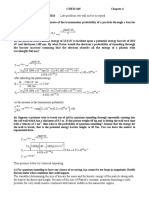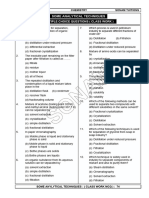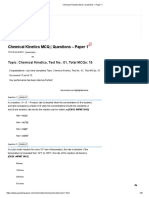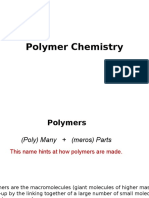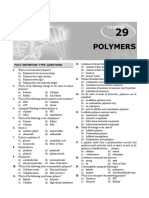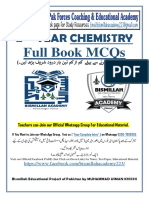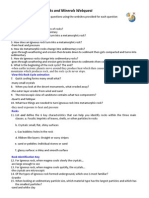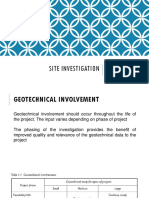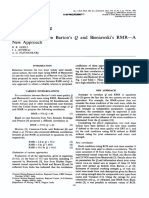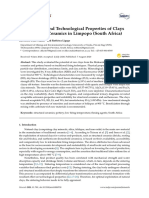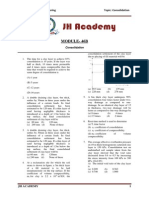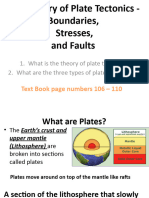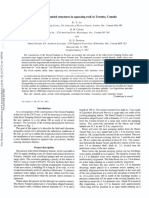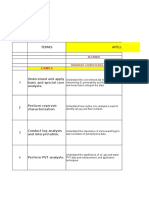Assignment 4: Sedimentary and Metamorphic Rocks: - Multiple Choice
Assignment 4: Sedimentary and Metamorphic Rocks: - Multiple Choice
Uploaded by
Saed CattywampusCopyright:
Available Formats
Assignment 4: Sedimentary and Metamorphic Rocks: - Multiple Choice
Assignment 4: Sedimentary and Metamorphic Rocks: - Multiple Choice
Uploaded by
Saed CattywampusOriginal Description:
Original Title
Copyright
Available Formats
Share this document
Did you find this document useful?
Is this content inappropriate?
Copyright:
Available Formats
Assignment 4: Sedimentary and Metamorphic Rocks: - Multiple Choice
Assignment 4: Sedimentary and Metamorphic Rocks: - Multiple Choice
Uploaded by
Saed CattywampusCopyright:
Available Formats
GEOL 1111: Introduction to Earth Science AF4-1
Assignment 4:
Sedimentary and Metamorphic Rocks
Please answer the following questions in the spaces provided. Marks are as
indicated.
Part 1—Multiple Choice
(10 Marks)
Please answer these questions by circling the appropriate answer.
1. Sedimentary rocks:
a) may contain fossils
a) hold important clues to the earth’s history
b) are layered
c) may contain economically important materials
d) all of the above
2. Clastic sedimentary rocks are classified primarily on the basis of:
a) colour
b) type of bedding
c) mineral composition
d) particle size
e) depositional environment
3. Which if any of the following is NOT a sedimentary structure?
a) cross-bedding
b) mud cracks
c) ripple marks
d) bedding planes
e) all are sedimentary structures
TRU Open Learning
AF4-2 Assignment 4: Sedimentary and Metamorphic Rocks
4. Which rock type is associated with a high-energy environment (such as a very
turbulent stream)?
a) conglomerate
b) shale
c) both a and b
d) neither a nor b
5. The most common minerals in clastic sedimentary rocks are:
a) quartz and olivine
b) calcite, and clay minerals
c) halite and feldspar
d) clay minerals and quartz
e) dolomite and gypsum
6. Metamorphism may result from:
a) heat
b) pressure
c) chemical action
d) any or all of these
e) only a and b
7. Contact metamorphism:
a) occurs in close proximity to a mass of magma
b) produces aureoles
c) often produces dense, fine-grained, non-foliated rocks
d) all of the above
e) both a and b
8. Which of the following changes may occur during metamorphism?
a) certain minerals may recrystallize
b) a preferred fabric may develop
c) crystals may grow larger
d) all of the above
e) both a and b
TRU Open Learning
GEOL 1111: Introduction to Earth Science AF4-3
9. When certain minerals recrystallize with a preferred orientation that is
perpendicular to the direction of the compressional force, the rock is said to
exhibit:
a) shear
b) foliation
c) aureole
d) all of the above
e) none of the above
10. Which of the following is NOT true about slate?
a) exhibits excellent rock cleavage
b) contains minute mica flakes
c) results from the high-grade metamorphism of sandstone
d) may exhibit different colours
e) evidence of former sedimentary bedding planes may still exist
TRU Open Learning
AF4-4 Assignment 4: Sedimentary and Metamorphic Rocks
Part 2—Sample Kit Questions
(20 Marks)
To answer the questions in this section, please refer to the rock and mineral samples
in your lab kit.
11. Assuming that samples #3, #4, and #6 were all deposited along the same river,
arrange the samples in the sequence you would expect to find them in a
downstream direction. (2 marks)
Upstream Downstream
#6 Conglomerate #3 Sandstone #4 Shale
12. In what type of environment did samples #29, #2 and #4 form? (3 marks)
Sample #29 (gypsum)
Environment lake and sea water, as well as in hot springs, from volcanic vapors,
and sulfate solutions in veins
Sample #2 (limestone)
Environment marine environment
Sample #4 (shale)
Environment lakes and lagoonal deposits, in river deltas, on floodplains and
offshore from beach sand
13. Have rock samples #6 and #3 experienced a long or short history of
transportation during their formation? For each sample, give two reasons to
support your answer. (4 marks)
Sample #6 (conglomerate):
Transport history: Some transport, particles may not travelled very far
Evidence Some transport made the particles rounded but the transportation
was not very much further because it is coarse grained
Sample #3 (sandstone):
Transport history Transported a great distance
Evidence The grains in the sandstone is well sorted and well-rounded which
indicates a great transportation history
TRU Open Learning
GEOL 1111: Introduction to Earth Science AF4-5
14. #4 indicate about the conditions under which they formed? (1 mark)
Sample #7: Arkose has more than 25% of feldspar. Rapid erosion associated
with rugged terrain allows feldspar to be mechanically weathered to form arkose
Sample #4: Lithification and cementation. Shale undergoes pronounced
compaction as they lithify from wet mud
15. Under what conditions was sample #1 formed? (1 mark)
Sample #1 (bituminous coal)
Bituminous coal is an organic sedimentary rock formed by diagenetic and sub
metamorphic compression of peat bog material. Formation is usually the result
of high pressure being exerted on lignite.
16. What is its relation to sample #20? (1 mark)
Sample #20 (anthracite coal)
Anthracite coal is a metamorphic rock as opposed to bituminous coal (#1 is
sedimentary) formed by natural continuation thermal maturation of coal during
burial, as result of compression during tectonic deformation, and by
devolatization during low grade contact metamorphism.
17. Arrange samples #18, #38, and #16 in order of decreasing metamorphic grade.(2 marks)
Highest grade Lowest grade
#18 Gneiss #38 Garnet mica schist #16 Slate
18. Arrange samples #10, #2, and #15 as you would expect to find them as you
approached an igneous intrusion (i.e., a source of contact metamorphism).
(2 marks)
Country rock Aureole Intrusion
#2 Limestone #15 Marble #10 Granite
19. What type of metamorphism has been responsible for the formation of
the following metamorphic rocks and what is the evidence for your answer?
(2 marks)
Sample #19 (quartzite):
Type Contact and/or regional metamorphism
TRU Open Learning
AF4-6 Assignment 4: Sedimentary and Metamorphic Rocks
Evidence
Quartzite found in an aureole, are the nonfoliated rocks contact metamorphosed
from quartz sandstone. Quartzite also form under conditions of regional
metamorphism. When grains of quartz recrystallize, they tend to be
equidimensional, rather than elongate. They don’t exhibit any foliation even if
subjected to differential stress during regional metamorphism,
Sample #38 (garnet-mica schist):
Type Regional metamorphism
Evidence Garnet-mica schist rocks are almost always foliated, indicating
differential stress during recrystallization
20. Compare sample #8 (syenite) and #18 (gneiss). What are the major: (2 marks)
Similarities Both has amphibole and coarse. Both rocks split into slabs having
approximately parallel surfaces
Differences Gneiss contains quartz but syenite is quartz-poor
TRU Open Learning
GEOL 1111: Introduction to Earth Science AF4-7
Part 3—Field Exercise
(20 Marks)
21. This exercise involves fieldwork and some follow-up research at home.
a) Collect a sample of a sedimentary or metamorphic rock from your locality.
Do not submit one of the samples from your lab kit.
b) In the space below, briefly describe the sample location (e.g., a rock outcrop,
stream bed, beach, etc.). Sketch or photograph the sample site, remembering
to show a measure of scale such as a notebook, hammer or person, and where
the sample site is located. A word of caution: Stream beds or beaches are not
generally good places to find sedimentary rocks because sedimentary rocks
tend to be weak and soft and they get quickly ground up in a stream
environment. On the other hand, you might find metamorphic rocks, such
as gneiss or schist in the gravel of a stream bed or on a beach. (5 marks)
Site Description:
The site shown below is at Botanical beach, located on the Strait of Juan de
Fuca on the west coast of Southern Vancouver Island. Photo is taken at the
Eastern side of Botanical Beach, consists of weather resistant natured rocks,
sediments, pebble – cobble material with logs at the head of beach.
Sketch / Photo of Sample Site (use extra paper if necessary)
Photo was taken by Saeedul Alam. 26-Spet-2015
TRU Open Learning
AF4-8 Assignment 4: Sedimentary and Metamorphic Rocks
i. Describe sample texture and composition. Please send a fragment
(about the size of the samples in your lab kit) of the sample to your
Open Learning Faculty Member so that your analysis can be checked.
Keep the remainder of the sample for yourself for future reference.
Sample Photo: I have attached a close up photo of the sample fragment
instead.
Figure: possible slate specimen (Photo was taken by Saeedul Alam. 26-Spet-2015)
Texture: (5 marks)
(Describe grain size, grain shape, and structures visible in hand specimen.)
The sample is found to be very fine grained so that individual minerals
cannot be identified. It has a salty cleavage, and very easy to split along
smooth faces. The surface of the rock has a brown dull lustre.
Composition: (5 marks)
(Try to give an estimate of the percentage proportions of minerals in sample.)
It is too fine grained to disclose any distinct individual grains
c) Provide a name and inferred geological origin of your specimen. Compare
your sample with the descriptions and classification of sedimentary or
metamorphic rocks in your textbook and Lab Manual.
Name: (2 marks)
TRU Open Learning
GEOL 1111: Introduction to Earth Science AF4-9
I have identified the sample as slate. I have compared with #15 from lab kit,
both are very easy to split along smooth faces, and both are very fine grained.
The sample color is brown and the lab kit sample is more reddish.
Inferred geologic setting: (i.e., how and where did this rock form, and how
did it get here?) (3 marks)
It has derived from shale type sedimentary rock composed of clay or volcanic
ash through low grade metamorphism. My speculation is may be a former
sedimentary basin that became involved in a convergent plate boundary
formed the slate samples around Juan de Fuca strait.
TRU Open Learning
AF4-10 Assignment 4: Sedimentary and Metamorphic Rocks
Part 4—Relative Dating
(10 Marks)
Photograph 25 shows a sequence of igneous and metamorphic rocks found at
Caulfeild Park in West Vancouver. The rocks could be briefly described as follows:
A. Fine-grained grey porphyritic volcanic rock with black needle-like
phenocrysts of hornblende.
B. Distinctly folded black and white banded and foliated metamorphic rock
composed of quartz and feldspar (light bands), and hornblende and
plagioclase feldspar (dark bands).
C. Thin veins of white quartz.
D. Black and white speckled (but appears mostly white in photograph)
coarse-grained igneous rock composed primarily of quartz, orthoclase
feldspar, Na-feldspar, and biotite mica.
22. In the space below, draw a sketch of the photograph, showing the four rock
types; label them A, B, C, and D as described above. (5 marks)
TRU Open Learning
GEOL 1111: Introduction to Earth Science AF4-11
23. Using the principle of cross-cutting relationship described on pages 195-199 of
your textbook, list the order in which these rocks formed, from oldest to
youngest. (Note: These are not sedimentary rocks, so the principle of
superposition does not apply.) (2 marks)
Oldest Youngest
B A D C
24. Rock B is folded. Did this folding occur before or after the formation of the other
three rock types? What is the evidence for your answer? (1 mark)
Folding for rock B occurred before the formation of other rocks. Folded rock B is
cut by Rock C and A. From principle of rock cutting relations, igneous intrusions
are younger than the rocks they cut. Rock D shows as a roof pendant which is
younger rock than B.
25. Choose the most appropriate samples from your lab kit that would correspond
with the four rock types described above. Provide names for all 4, including
Rock A. (2 marks)
Lab kit sample # Name
Rock A (none), #39 Fine-grained grey porphyritic rick with
phenocrysts of hornblende
Rock B #31, #28, #39 Quartz, Feldspar, Hornblende
Rock C #31 Quartz
Rock D #28, #31, #37 Feldspar, Quartz, Biotite Mica
TRU Open Learning
AF4-12 Assignment 4: Sedimentary and Metamorphic Rocks
Part 5—Essay Questions
(40 Marks)
26. Write a short essay (no more than two pages), giving specific examples where
appropriate, explaining why sedimentary rocks are particularly useful in
determining the history of the earth. (20 marks)
In geology, correlation usually means determining time equivalency of rock units.
Fossils are common in sedimentary rock, and their presence is important for
correlation. Plants and animals that lived at the time the rock formed were buried by
sediment, and their fossil remains are preserved in sedimentary rock. Smith’s
discovery of this principle of faunal succession allowed rock layers in different
places to be correlated based on their fossils any period of time in Earth history can
be identified by the species that lived at that time. Therefore, sedimentary rock
layers anywhere in the world can be assigned to their correct place in geologic
history by identifying the fossils they contain. Fossils in the lowermost horizontal
layers of the Grand Canyon are comparable to ones collected in Wales, Great Britain,
and many other places in the world. We can, therefore, correlate these rock units and
say they formed during the same general span of geologic time. Any time sediment
is deposited, it leaves distinctive traces of chemical and evaporation process and
the environment; in other words, the conditions under which it was deposited, and
each of many different depositional environments can create similar results even
though the materials may be quite different in composition. Knowing these
depositional environments, and knowing the sedimentary processes, and looking at
the rocks that we find in a particular region can help us then to unravel the geologic
history of an area. Geologists interpret the characteristics of sedimentary rock using
the principle of uniformity. This principle is a model of the way sedimentary rocks
form. According to this model, we accept that sedimentary rocks are formed
throughout geologic time in exactly the same way that sediments are forming today.
Throughout Earth history the same geologic processes, such as weathering, running
water, wind, tide, changing sea level have created and deposited sediment that
eventually were hardened to rock. The principle of uniformity says that the present
is the key to the past, so as we study sediments being deposited right now and
associate their characteristic with the conditions at the Earth's surface, we're creating
a model for interpreting environment in the geologic past. This limestone, for
example, is made of grade calcium carbonate mud, a little poured sand, and the
fossils of marine organisms. Sediments being deposited in shallow tropical seas,
such as the Bahamas and the Florida Keys would look very much like this limestone
if they were hardened into rock, so in this case uniformity is telling us that this area
was covered by a shallow tropical sea about 250 million years ago.
TRU Open Learning
GEOL 1111: Introduction to Earth Science AF4-13
27. Write a short essay (no more than two pages) summarizing the most important
aspects of the information provided in Chapter 7 “Metamorphism, Metamorphic
Rocks, and Hydrothermal Rocks” and Program 18 “Metamorphic Rocks”.
(20 marks)
Answer:
Metamorphic rocks arise from the transformation of existing rock types, in a process
called metamorphism. Metamorphism also involves alterations, but the changes are
due to deep burial, tectonic forces, and/or high temperature rather than conditions
found at Earth’s surface. Water from the hydrosphere seeps through cracks and
pores in rocks and may penetrate to at least the shallower depths where
metamorphism is taking place. Water is also incorporated in minerals that form
during igneous and sedimentary processes. When rock containing these minerals is
subducted or otherwise carried to depth and heated, the water is driven out of these
minerals, affecting the metamorphic process. Metamorphic rocks are exposed over
large regions because of erosion of mountain belts and its accompanying uplift due
to isostatic adjustment. During metasomatism, hot water introduces ions into a rock
being metamorphosed, changing the chemical composition of the metasomatized
rock from that of the parent rock. Metamorphic rocks are subjected to high
temperature, generally accompanied by high confining pressure. Foliation in
metamorphic rocks is due to differential stress and it can be either compressive
stress or shearing. Regional metamorphic rocks are almost always foliated,
indicating differential stress during recrystallization. Slate, phyllite, schist, and
gneiss are foliated rocks that indicate increasing grade of regional metamorphism.
Contact metamorphic rocks are produced during metamorphism usually without
significant differential stress but with high temperature. Contact metamorphism
occurs in rocks immediately adjacent to intruded magmas. Regional metamorphism
has created most of the metamorphic rock of Earth’s crust. Different parent rocks as
well as widely varying combinations of pressure and temperature result in a large
variety of metamorphic rocks. Combinations of minerals in a rock can indicate what
the pressure and temperature conditions were during metamorphism. Migmatite is
a rock that is a mixture of metamorphic rock and igneous rock. It is created when a
metamorphic rock such as gneiss partially melts, and then that melt recrystallizes
into an igneous rock, creating a mixture of the unmelted metamorphic part with the
recrystallized igneous part. Plate-tectonic theory accounts for the features observed
in metamorphic rocks and relates their development to other activities in Earth. The
five basic metamorphic textures with typical rock types are slaty (includes slate and
phyllite; the foliation is called "slaty cleavage"), schistose (includes schist; the
foliation is called "schistosity"), gneissose (gneiss; the foliation is called
TRU Open Learning
AF4-14 Assignment 4: Sedimentary and Metamorphic Rocks
"gneissosity"), granoblastic (includes granulite, some marbles and quartzite), and
hornfelsic (includes hornfels and skarn).
This is the end of Assignment 4
Please submit your assignment to your Open Learning Faculty Member.
TRU Open Learning
You might also like
- 5e DND Owning A Mine: Monthly MaintenanceDocument2 pages5e DND Owning A Mine: Monthly MaintenanceAllan WestNo ratings yet
- WORKSHEET 1: Determination of Oxidation Number or Valence NumberDocument11 pagesWORKSHEET 1: Determination of Oxidation Number or Valence NumberGunay Omarova100% (1)
- Chapter 4 Practice TestDocument3 pagesChapter 4 Practice TestMarjorie BrondoNo ratings yet
- DMYCO3dp-001 Installation Guide v.07Document26 pagesDMYCO3dp-001 Installation Guide v.07Saed CattywampusNo ratings yet
- Geology of Vancouver IslandDocument23 pagesGeology of Vancouver IslandSaed CattywampusNo ratings yet
- Well Completion and Stimulation - Chapter 2 Well Completion Design NewDocument24 pagesWell Completion and Stimulation - Chapter 2 Well Completion Design NewsouthliNo ratings yet
- M.SC - Chemistry - 2016Document20 pagesM.SC - Chemistry - 2016rmsh301No ratings yet
- Chemistry MCQs Second Year FSC Punjab Board PakistanDocument73 pagesChemistry MCQs Second Year FSC Punjab Board PakistanSaharGCWUF65% (17)
- 4.1 MIS and NJS Manual For Inorganic Semi-Micro Qualitative Analysis PDFDocument17 pages4.1 MIS and NJS Manual For Inorganic Semi-Micro Qualitative Analysis PDFShivam MeraviNo ratings yet
- Complete Physical Chemistry McqsDocument13 pagesComplete Physical Chemistry Mcqszafarchem_iqbalNo ratings yet
- BHU M.SC Chemistry Entrance Exam PaperDocument32 pagesBHU M.SC Chemistry Entrance Exam Paperutkarsh130896No ratings yet
- M.SC - Chemistry - 2018Document24 pagesM.SC - Chemistry - 2018Abdi mohammedNo ratings yet
- Lanthanides and ActinidesDocument24 pagesLanthanides and ActinidesRameshkumar100% (1)
- XII Chemistry Preparation Paper 2020Document16 pagesXII Chemistry Preparation Paper 2020Abdul100% (1)
- Metamorphic Rocks LabDocument12 pagesMetamorphic Rocks LabvishalukeyNo ratings yet
- OrganicChemistryChapter5 PDFDocument19 pagesOrganicChemistryChapter5 PDFJuliet Tatiana CumbeNo ratings yet
- Test Polymer Unit With Answer KeyDocument4 pagesTest Polymer Unit With Answer KeyGellene GarciaNo ratings yet
- (3335) DPP 17 Chemical Bonding BDocument2 pages(3335) DPP 17 Chemical Bonding BRAJDEEP DASNo ratings yet
- Csir-Net June 2013 Chemical Science Detail SolutionDocument40 pagesCsir-Net June 2013 Chemical Science Detail SolutionDushyant Patel100% (1)
- Organic Chemistry Syllabus Final VersionDocument5 pagesOrganic Chemistry Syllabus Final VersionYseemaz AzeeraNo ratings yet
- PG M.sc. Chemistry 34431 Advanced Inorganic ChemistryDocument207 pagesPG M.sc. Chemistry 34431 Advanced Inorganic ChemistryinuperuvaikalaNo ratings yet
- Chemistry - MCQDocument30 pagesChemistry - MCQjoydeep_d32320% (1)
- GEOL211 Final Exam Answer KeyDocument4 pagesGEOL211 Final Exam Answer KeyPHEBY MOOGNo ratings yet
- Carboranes AgapinDocument17 pagesCarboranes AgapinJulienne Stephanie Fabie100% (1)
- CBSE Class 11 Chemistry Worksheet - Chemical Bonding and Molecular StructureDocument1 pageCBSE Class 11 Chemistry Worksheet - Chemical Bonding and Molecular StructureNikhil KumarNo ratings yet
- Chem 64 Problem Set 2: Molecular Symmetry and Group Theory: N H N N NH H H CL CL BR CL G) orDocument3 pagesChem 64 Problem Set 2: Molecular Symmetry and Group Theory: N H N N NH H H CL CL BR CL G) orIpungNo ratings yet
- 1st Year Chemistry Chapter 2Document3 pages1st Year Chemistry Chapter 2Zeeshan ahmedNo ratings yet
- 9TH Class Chemistry Guess PaperDocument11 pages9TH Class Chemistry Guess PaperMarkpiciNo ratings yet
- Free Radical PolymerizationDocument11 pagesFree Radical PolymerizationNaveed AhmadNo ratings yet
- General Principles and Processes of Isolation of ElementsDocument12 pagesGeneral Principles and Processes of Isolation of ElementsBhavesh KNo ratings yet
- GATE Chemistry Study Material Book 1 Inorganic Chemistry 1Document21 pagesGATE Chemistry Study Material Book 1 Inorganic Chemistry 1Sudhanshu PandeyNo ratings yet
- 02 - Inorganic Chemistry-MCQ With Answer PDFDocument5 pages02 - Inorganic Chemistry-MCQ With Answer PDFsubeesh up100% (1)
- Acid-Base Chemistry. Extra Practice Problems General Types/Groups of ProblemsDocument13 pagesAcid-Base Chemistry. Extra Practice Problems General Types/Groups of ProblemsYeabisraNo ratings yet
- Organic Chemistry PDFDocument4 pagesOrganic Chemistry PDFAnkush BiswasNo ratings yet
- Periodic Table Crystal StructureDocument6 pagesPeriodic Table Crystal StructurearamontanaNo ratings yet
- NMR CouplingDocument72 pagesNMR CouplingShrutiNo ratings yet
- Born-Haber CycleDocument21 pagesBorn-Haber CycleГульдана КуанткановнаNo ratings yet
- PracticalsDocument158 pagesPracticalsBirajuNo ratings yet
- Quantum Solutions 2016Document3 pagesQuantum Solutions 2016JoanaNo ratings yet
- Some Analytical Techniques C.W CMDocument4 pagesSome Analytical Techniques C.W CMkillerboy9474100% (1)
- 2nd Year Chemistry Mcqs Notes ChapterwiseDocument150 pages2nd Year Chemistry Mcqs Notes ChapterwiseHaris KhanNo ratings yet
- X Class - SSC Andhra Pradesh Physics Differences AnswersDocument4 pagesX Class - SSC Andhra Pradesh Physics Differences Answersmanawarangal100% (1)
- Chemistry Task1 Past HSC QuestionsDocument8 pagesChemistry Task1 Past HSC QuestionsJennifer MooreNo ratings yet
- Chemical Kinetics MCQ - Questions - Paper 1Document5 pagesChemical Kinetics MCQ - Questions - Paper 1sadaf yousafzaiNo ratings yet
- Blue Print of ChemistryDocument2 pagesBlue Print of ChemistryMDHA50% (2)
- Terpenoids: T.Y.B.Sc Sem - Vi Unit-Ii (A) Chemistry Paper-Vii (Organic Chemistry)Document39 pagesTerpenoids: T.Y.B.Sc Sem - Vi Unit-Ii (A) Chemistry Paper-Vii (Organic Chemistry)abhishek ajmeri100% (1)
- Polymer Chemistry 16 17 I SemDocument69 pagesPolymer Chemistry 16 17 I SemSam WhiteNo ratings yet
- 3-Organic Synthesis (MSC 4th Sem)Document83 pages3-Organic Synthesis (MSC 4th Sem)madhu9347253214100% (1)
- Phy CH 6 Final 9thDocument16 pagesPhy CH 6 Final 9thBasit KhanNo ratings yet
- CSIR Previous PapersDocument141 pagesCSIR Previous PapersSony mulgundNo ratings yet
- Polymers: Fact / Definition Type QuestionsDocument12 pagesPolymers: Fact / Definition Type QuestionsChetna GuptaNo ratings yet
- 2nd Year CHEMISTRY Full Book Solved MCQs by Bismillah Academy 0300-7980055Document52 pages2nd Year CHEMISTRY Full Book Solved MCQs by Bismillah Academy 0300-7980055Malaika MinerNo ratings yet
- Advanced Organometallic Chemistry and Its Applications in Industry and Catalytic Reactions PDFDocument144 pagesAdvanced Organometallic Chemistry and Its Applications in Industry and Catalytic Reactions PDFdustinthewindNo ratings yet
- Chem Test No. 4 (Alkyl Halides, Alcohol and Phenols)Document4 pagesChem Test No. 4 (Alkyl Halides, Alcohol and Phenols)fahadmustafa100% (1)
- Neet - 2017 Test Series Two Dimensional Motion & Work Power EnergyDocument4 pagesNeet - 2017 Test Series Two Dimensional Motion & Work Power Energyumved singh yadav100% (1)
- Per I CyclicDocument44 pagesPer I CyclicPrasad YarraNo ratings yet
- Inorganic Chemistry: Duward Shriver and Peter AtkinsDocument65 pagesInorganic Chemistry: Duward Shriver and Peter AtkinsMilano TorresNo ratings yet
- Origin of CoalDocument20 pagesOrigin of CoalvitriniteNo ratings yet
- Revisiog 10Document6 pagesRevisiog 10hassan hamedNo ratings yet
- 10+2 Chem P-Block ElementsDocument44 pages10+2 Chem P-Block ElementsArjun PasrichaNo ratings yet
- Geo DPQ 2Document11 pagesGeo DPQ 2annalaanvithaNo ratings yet
- 4-Core Subhect-Science-11-Earth - Life Science-Q1-Module-4Document25 pages4-Core Subhect-Science-11-Earth - Life Science-Q1-Module-4agnes joy cepeNo ratings yet
- Rocks and Minerals Webquest5555555Document3 pagesRocks and Minerals Webquest5555555api-265544103No ratings yet
- _ Gr 5 Unit 2- Rocks and MineralsDocument5 pages_ Gr 5 Unit 2- Rocks and MineralsprekshapatelindNo ratings yet
- Ahmod Sofa Rochonaboli by Ahmed SofaDocument527 pagesAhmod Sofa Rochonaboli by Ahmed SofaSaed CattywampusNo ratings yet
- Dcu UgDocument34 pagesDcu UgSaed CattywampusNo ratings yet
- Read MeDocument2 pagesRead MeSaed CattywampusNo ratings yet
- ExtrusionsDocument1 pageExtrusionsSaed CattywampusNo ratings yet
- DMY3dp-001 Automatic Leveling Debug Guide V2Document5 pagesDMY3dp-001 Automatic Leveling Debug Guide V2Saed CattywampusNo ratings yet
- Vim Cheat SheetDocument1 pageVim Cheat SheetSaed CattywampusNo ratings yet
- Osaka - Himeji JR Special Rapid Service 15:13 - 16:16 61 MinsDocument1 pageOsaka - Himeji JR Special Rapid Service 15:13 - 16:16 61 MinsSaed CattywampusNo ratings yet
- Software Exorcism: A Handbook For Debugging and Optimizing Legacy CodeDocument13 pagesSoftware Exorcism: A Handbook For Debugging and Optimizing Legacy CodeSaed CattywampusNo ratings yet
- Site Investigation: Geo-S-513 Geological Investigation Geo-E-511 Subsurface Geological InvestigationDocument25 pagesSite Investigation: Geo-S-513 Geological Investigation Geo-E-511 Subsurface Geological InvestigationNimra KhanNo ratings yet
- Correlation Between Barton's Q and Bieniawski RMRDocument3 pagesCorrelation Between Barton's Q and Bieniawski RMRÁlvaro OleasNo ratings yet
- Composition and Technological Properties of ClaysDocument11 pagesComposition and Technological Properties of ClaysFOUTOUNo ratings yet
- Applying The Seismic Refraction Tomography For SitDocument5 pagesApplying The Seismic Refraction Tomography For SitNguyen Quoc KhanhNo ratings yet
- NPVS Course Level 2Document31 pagesNPVS Course Level 2Juan David Rondinel BulejeNo ratings yet
- 46BDocument7 pages46BJamie Schultz50% (2)
- Plate Tectonic - Grade 10Document36 pagesPlate Tectonic - Grade 10NELLY L. ANONUEVONo ratings yet
- Module 3 - Wonders of The WorldDocument16 pagesModule 3 - Wonders of The WorldADRIANO RODRIGO DA SILVANo ratings yet
- Running WaterDocument24 pagesRunning WaterpicefeatiNo ratings yet
- Fluvial LandformsDocument12 pagesFluvial LandformsSarveshVishnarNo ratings yet
- Origin Migrationn & Entrapment HC - SDocument23 pagesOrigin Migrationn & Entrapment HC - SAfzal Hayat FarooqiNo ratings yet
- Item Analysis TemplateDocument28 pagesItem Analysis TemplateMarvelous VillafaniaNo ratings yet
- Ch. 5 Minerals and Energy Resources Flash CardsDocument36 pagesCh. 5 Minerals and Energy Resources Flash CardsSAIJEEVAN SATHISHNo ratings yet
- 1-Rock Anchor PolicyDocument10 pages1-Rock Anchor PolicyManimaran PNo ratings yet
- Late Quaternary Paleohydrologic and Paleotemperature Change in Southern NevadaDocument24 pagesLate Quaternary Paleohydrologic and Paleotemperature Change in Southern NevadaJeff RobersonnNo ratings yet
- Do You Enjoy or Are You Good at Physics - A4CDocument1 pageDo You Enjoy or Are You Good at Physics - A4CTarmogoyfSucksNo ratings yet
- Report On Earthwork and Preparation of Sub-GradeDocument38 pagesReport On Earthwork and Preparation of Sub-GradeSally GranadaNo ratings yet
- Surface Subsidence Due To Underground Mining Operation Under Weak Geological Condition in IndonesiaDocument11 pagesSurface Subsidence Due To Underground Mining Operation Under Weak Geological Condition in IndonesiaSunil sahuNo ratings yet
- Highway Drainage 0734Document209 pagesHighway Drainage 0734Rajesh Khadka100% (1)
- Competency Matrix For Reservoir Engineering: General Knowledge/SkillDocument16 pagesCompetency Matrix For Reservoir Engineering: General Knowledge/SkillVanesa LunaNo ratings yet
- Empirical Performance Prediction For Raise Boring Machines BasedDocument24 pagesEmpirical Performance Prediction For Raise Boring Machines Basedyuyuhuhu789No ratings yet
- Journal of Petroleum Exploration and Production Technologies - Vol. 1, Numbers 1-4, 2011Document105 pagesJournal of Petroleum Exploration and Production Technologies - Vol. 1, Numbers 1-4, 2011anonms_accNo ratings yet
- Soil and Soil Mechanics Textbook Jaafar MOHAMMEDDocument145 pagesSoil and Soil Mechanics Textbook Jaafar MOHAMMEDpandianNo ratings yet
- Amal DAS GUPTA PALEONTOLOGYDocument618 pagesAmal DAS GUPTA PALEONTOLOGYAravindsad AravindsadNo ratings yet
- PERU PresentationDocument9 pagesPERU PresentationKaloqn TashevNo ratings yet
- Rock LabDocument4 pagesRock Labapi-317830512No ratings yet
- BlenkinsopDocument7 pagesBlenkinsopJHONNY OMAR LAURA QUISPENo ratings yet
- UAS Kelas 9 SMPDocument10 pagesUAS Kelas 9 SMPMaharani Queen100% (1)
